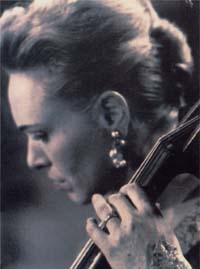

Alumni Gazette
Ars Antiqua Lives!
 |
| FOUNDER: Amarandos in an early 1960s performance with Ars Antiqua. (Photo: Courtesy Madeline Ingram) |
Dorothy Purdy Amarandos ’46E, ’47E (MM) long assumed the sounds of the pioneering early music performance ensemble that she founded with Eastman School alumni and teachers had died out with the group’s last performances in the mid-1960s.
She knew she had tapes of many of the performances at the Memorial Art Gallery and other Rochester venues.
After all, her son, George, had acted as the group’s unofficial sound engineer. As early as age 9, he made sure a tape recorder was turned on at each performance.
But as she moved from Rochester to Columbus, Ohio, and then to Washington, D.C., Amarandos didn’t hold out a lot of hope that the music on the tapes was salvageable.
“We didn’t know we could get anything out of them,” Amarandos says of the four-track tapes.
More than 40 years later, the music of Ars Antiqua has found new life on a four-CD set produced by Amarandos and released last fall.
Thanks to some technical production work and interest from several of the group’s former members, Amarandos has discovered not only that the tapes have held up over time, but that they contain remarkably good recordings of a special moment in her musical history.
“It’s such a joy to hear these after all these years,” she says.
A cellist, Amarandos was teaching at the Eastman School in the late 1950s when she became interested in early music—roughly defined as music written between the middle ages and the Baroque period—and taught herself to play the viola da gamba, a cello-like instrument whose popularity peaked in the 17th century.
Drawing on the interest and talents of Eastman alumni, teachers, and students, Amarandos put together Ars Antiqua, an ensemble whose members were versatile on the lute, sackbut (a trumpet-like horn), sordune (a double-reed wind), and other period reproductions of medieval instruments.
Unusual not only for its dedication to early music at a time when few others in classical music were, the group also was notable for its productions, which often included dancers, actors, and other period performances.
From 1960 to 1965, the group presented at least 22 productions. When the tapes were finally played, Amarandos was able to recover 17 programs.
The set of CDs includes 12 of those.
One of those performing on the CDs is Madeline Bramer Ingram ’45E, who played psalter and harpischord.
“We tried to make the performances as authentic as possible,” Ingram says of the group’s productions. She, too, was surprised to hear the ensemble again.
“We were amazed at the quality of the recordings,” Ingram says. “We were blown away by it.”
Amarandos had hoped to unveil the CDs last October at the Eastman Rochester Organ Initiative Festival, much of which took place in the Fountain Court at the Memorial Art Gallery, the same site for many of the performances of Ars Antiqua.
Says Amarandos of hearing the ensemble after 40 years: “It’s like going home again.”
—Scott Hauser
